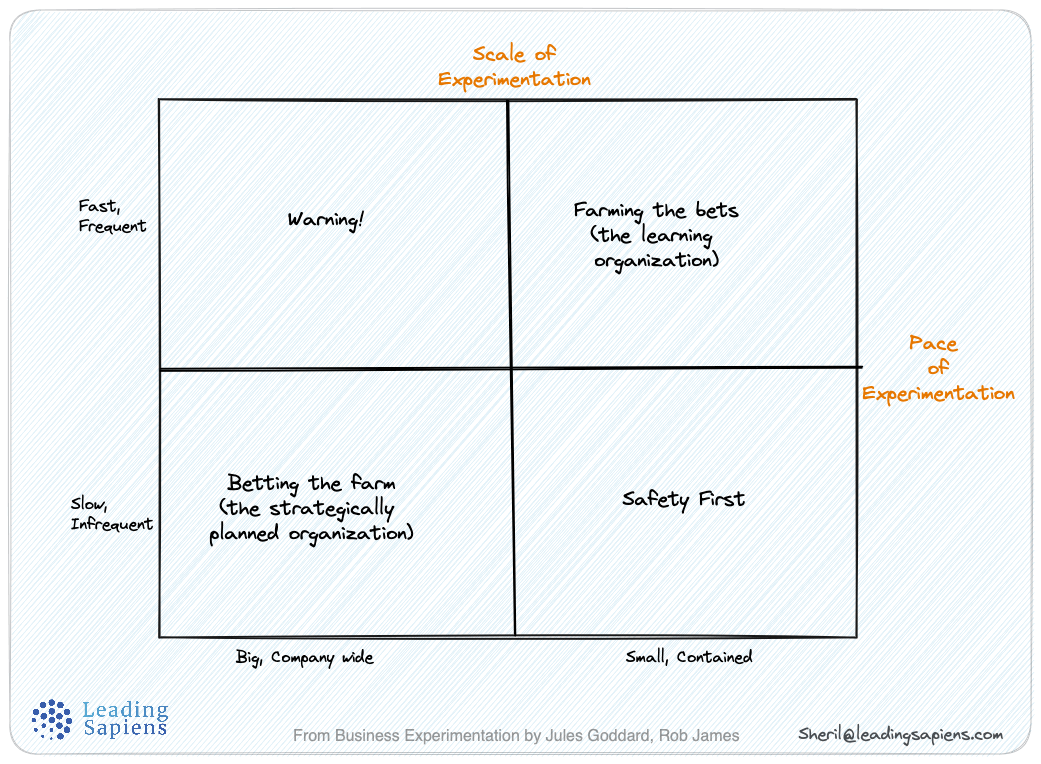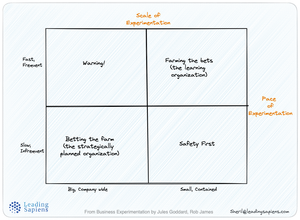In their book, Business Experimentation, Rob James and Jules Goddard highlight two approaches to strategy that are diametrically opposite to each other.
The lone big bet is still the norm
First is the traditional big bet approach characterized by centralized once a year planning, while the second is a culture of rapid, decentralized experimentation through multiple small bets leading to small wins that compound over time. One is slower to respond to real time changes, whereas the other is more nimble and adaptive.
For most companies, strategy is a single big bet. It is invented and formulated by quite a small team of senior executives. The view is that they are in the best position to see the future and create a winning formula. It is for the rest of the organization to implement it. There are, in effect, a small number of thinkers and a large number of doers.
Implementation becomes the performance-defining issue, and when things go wrong it is assumed to lie in clumsy execution rather than misconceived strategy. Thus, the dominant values of the organization will tend to be those of loyalty, alignment and solidarity. They reflect a managerial mentality grounded in habits of centralization, control and compliance. Yet it remains the case that ‘betting the farm’ on an untested bold conjecture is a huge gamble.
Even in the third decade of the twenty-first century, the notion of "small number of thinkers and large number of doers" is still the dominant approach in spite of overwhelming evidence that it's not in fact the best strategy in a variety of scenarios. That notion is also the source of glaring disconnects between ivory tower ideas and reality on the front lines.
Leveraging serendipity
Meanwhile, an experimental small wins methodology makes it easier to involve everyone and thus more responsive to and in tune with what's actually needed.
In contrast to the single big bet, ‘planned serendipity’ can be seen in the dramatic success of the ‘marginal gains’ methodology made famous by the Tour de France victories of Team Sky, coached by Sir Dave Brailsford. Applied to business, this is a technique of thinking that focuses on incremental changes to everything in the organization, 1 per cent at a time.
Unlike the big bet strategy, it relies upon the compounding effect of multiple small wins. ...It is a form of piecemeal engineering. In earlier times, it was called evolutionary operation (EVOP), emulating the variation and selection method of Darwinian theory.
Of the hundreds of experiments that led to British cyclists winning 178 world championships and 66 Olympic or Paralympic gold medals between 2007 and 2017, here are just a handful:
• Tires gained grip by being coated with alcohol.
• Racing suits were tested in wind tunnels to become more aerodynamic.
• Workouts were enhanced through biofeedback sensors.
• Muscle recovery was accelerated by certain massage gels.
• A good night’s sleep was improved by particular pillows and mattresses.
• Muscle temperature was optimized by wearing electrically heated overshorts.
• Finely tuned bikes were degraded even by small amounts of dust in the team truck.
Marginal gains such as these should serve as an inspiration to any organization that aspires to excel. Strategy for the experimental company is managed as an emergent process – more like a shower of arrows fired into the future than a preconceived plan being remorselessly rolled out.
Betting the farm vs Farming the bets
They give a matrix of approaches and make the useful distinction of "betting the farm" vs "farming the bets", that's useful when thinking about rolling out initiatives. On one end is the big company wide push while on the other end are smaller, more frequent but localized experiments. While there is no one right answer, looking at our particular project on the spectrum can shed some new light.
Experiments can be big, ‘bet the farm’ type experiments: the entire company becomes the hypothesis and therefore, by definition, they are a rare occurrence for the firm adopting such an experiment. Equally, experiments can be small, ‘farm the bets’ type experiments: each experiment is contained within a small part of the company and therefore many experiments can be running concurrently.

Every new business is self-evidently a single bet. It is testing one big idea. But as the business grows, and as it becomes multi-divisional, the opportunity for multiple experimentation expands. Most of the examples in this book are experiments conducted synchronously within different parts of the same organization. This is what we mean by an experimental culture.
In some organizations, such as booking.com and Amazon, hundreds, if not thousands, of fast-paced, tightly designed experiments are running in parallel. This style of experimentation lies at the heart of what has been called the ‘learning organization’. It contrasts sharply with the organization that still relies solely upon a yearly strategic planning process to place its bets and steer its course.
Where on the spectrum does your new initiative lie? Is it an emergent small win or is it a top-down, perfectly planned behemoth? Is it the best fit for what you are trying to achieve? How can you change the risk profile by changing your location on the spectrum?
Sources
1. Business Experimentation, A practical guide for driving innovation and performance in your business by Rob James, Jules Goddard.


